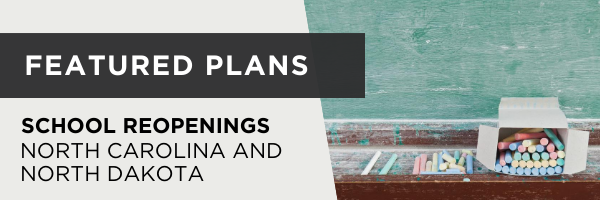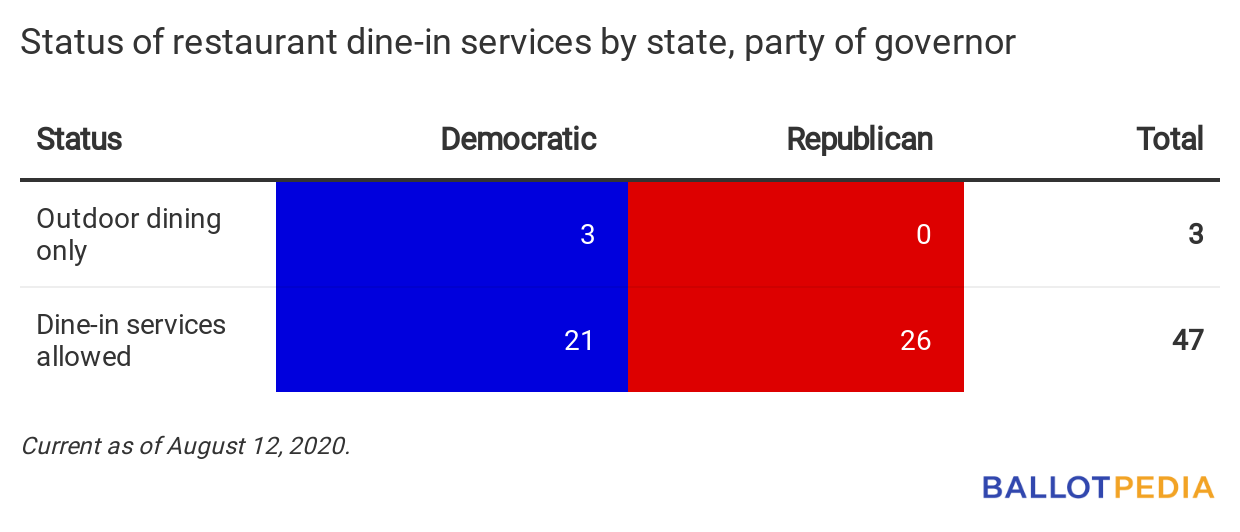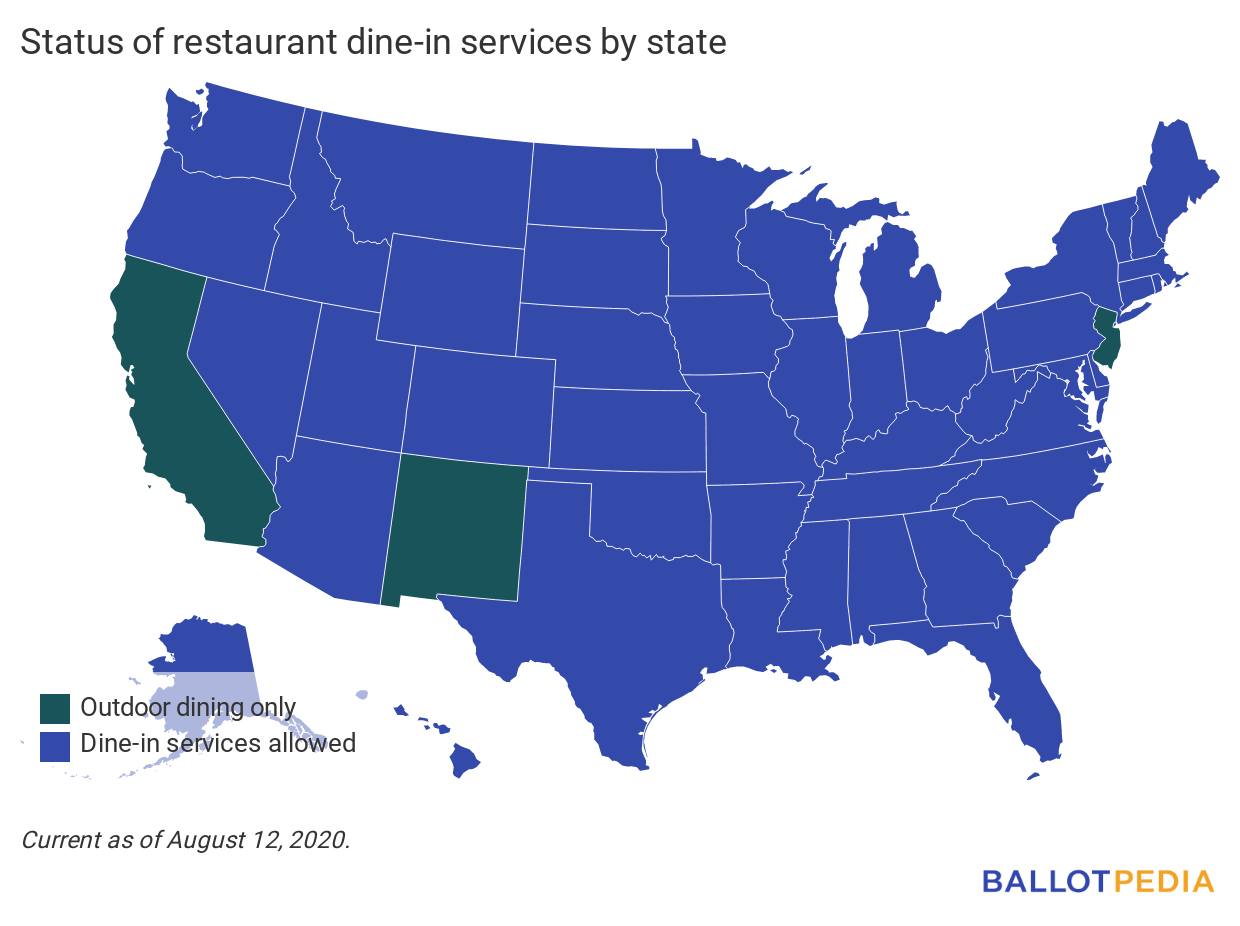Each day, we:
Want to know what happened yesterday? Click here.
Since our last editionWhat is open in each state? For a continually updated article on reopening status in all 50 states, click here. For our last edition, click here.
Tracking industries: RestaurantsAll 50 states are reopening in some way. Here, we give the status of one industry or activity across the states. Today’s question: in which states may you dine in at a restaurant? We last looked at restaurants in the August 5th edition of the newsletter. Since then, no states have opened or closed dine-in services. On Aug. 10, New Jersey Gov. Phil Murphy (D) said it was still too risky to allow indoor dining across the state, citing a study on the spread of the virus in a restaurant in China.
|
|||||||||||||||||||||||||||||||||||||||||||||||||||||||||||||||||||||||||||||||||||||||||||||||||||

This is an in-depth summary of two state plans to reopen public K-12 schools for the 2020-2021 school year. North Carolina’s Lighting Our Way ForwardOn June 11, 2020, the State Board of Education approved the North Carolina Department of Public Instruction’s, plan for school re-opening, Lighting Our Way Forward. On July 14, North Carolina Gov. Roy Cooper (D) announced that schools must operate under either a hybrid or fully-online plan. Districts are required to offer online-only instruction for students who are at high risk or who choose not to return to in-person instruction. In his announcement, Cooper said, “There are no decisions more important than the ones about our children and our schools. This announcement today is the result of careful, collaborative, and painstaking work. There is much risk in not going back to in-person school. We know that schools provide so much more than just academic lessons.” Public schools operating on a traditional schedule will begin instruction on August 17. According to EdWeek, public schools in North Carolina traditionally start the year in late August. Cooper closed public schools in the state for two weeks on March 14. On March 23, he extended the closure through May 15. On April 24, he announced that public schools were closed for the remainder of the school year. ContextNorth Carolina has a divided government. The governor is a Democrat, and Republicans have majorities in both chambers of the state legislature. The state has had a divided government since 2017. The following tables show public education statistics in North Carolina, including a rank comparing it to the other 49 states. Rank one is the highest number of each figure, rank 50 is the lowest. All data comes from the Common Core of Data provided by the National Center for Education Statistics.
DetailsDistrict reopening plans School districts are required to develop their own reopening plans that comply with the requirements outlined in the state’s guidance document. Those plans are:
Individual districts may choose to open under Plan B, which has some in-person instruction, or Plan C, which is entirely virtual. All districts are required to offer a fully virtual option. Schools may choose between Plan B or Plan C at any time. In-person, hybrid, and online learning Districts that choose a hybrid model are required to limit capacity to a level that will allow students and staff to adhere to a six-foot social distance. The state’s reopening guidelines suggest that scheduling for hybrid learning should be determined by individual school districts. The guidelines offer suggestions for alternating days, alternating weeks, or blending which grade levels would attend in person and which would attend virtually. Mask requirements All students, teachers, and staff are required to wear masks or face coverings. In-person health recommendations and requirements On June 8, 2020, the North Carolina Department of Health and Human Services released the StrongSchoolsNC Public Health Toolkit, a series of guidelines for in-person public education. When learning is done in-person, the following precautions are required, according to EducationNC:
Schools must conduct regular screenings for COVID-19 symptoms and isolate individuals who show symptoms. Staff and students must stay home if they test positive for COVID-19, show symptoms, or have come in close contact with a person who has COVID-19. The guidelines provide criteria to return for three scenarios:
Schools are required to ensure that six feet of distance is possible and marked out for students and staff during times where students and staff are more likely to come in contact, such as at lunch or during recess. Capacity for common areas is limited to the number that would allow for six-foot social distancing. Transportation and busing requirements and restrictions The state’s face mask requirement for students and staff also applies to transportation. Buses are limited to one student per seat. Screening for symptoms, including temperature checks, may be conducted prior to boarding transportation. ResponsesAfter Cooper announced that districts would have the option for reopening under Plan B or Plan C, North Carolina Association of Educators President Tamika Walker Kelly said, said:
North Carolina Senate Leader Phil Berger (R) criticized Cooper’s decision to limit district choices to Plans B and C. In a statement, Berger said:
North Dakota’s K-12 Smart RestartThe North Dakota Department of Public Instruction released its school reopening guidance, titled K-12 Smart Restart, on July 14. Gov. Doug Burgum (R) said, “North Dakota’s children are looking to us as adults to help them adjust to life with COVID-19. They will be watching us and looking to us for answers, guidance and security. Today’s guidance is the next step in that journey. We are committed to supporting and partnering with our schools and families to provide a safe, high-quality education experience for all students.” State Superintendent Kirsten Baesler said, “School boards and administrators will be making difficult decisions to ensure the health and well-being of their communities and limit the spread of COVID-19 while fulfilling their overall mission of educating students. They are in the best position to make the dozens and dozens of judgment calls that will be necessary every day and changing as the days go on.” North Dakota does not have a statewide date for public schools to reopen. According to EdWeek, public schools in North Dakota traditionally start the academic year in late August to early September, with the exact start date varying by district. On March 15, Gov. Burgum closed schools for one week, effective March 16. On March 19, Burgum extended the closure indefinitely. The governor closed schools for the rest of the academic year on May 1. On May 11, he announced schools could reopen starting on June 1 for summer programs, though they were not required to. ContextNorth Dakota has a Republican trifecta. The governor is a Republican, and Republicans hold majorities in both chambers of the state legislature. The state became a Republican trifecta in 1995. The following tables show public education statistics in North Dakota, including a rank comparing it to the other 49 states. Rank one is the highest number of each figure, rank 50 is the lowest. All data comes from the Common Core of Data provided by the National Center for Education Statistics.
DetailsDistrict reopening plans Each school district is responsible for developing Health and Safety plans regarding in-person instruction, which district school boards must approve in consultation with local public health units. Each school is also required to have a board-approved Distance Learning Plan, along with a hybrid plan. Schools are required to post the plans on a publicly accessible website. In-person, hybrid, and online learning The state’s reopening guide sets forth a color-coded phased approach to returning students to classrooms. The levels—Red (critical risk), Orange (high risk), Yellow (moderate risk), Green (low risk), and Blue (new normal)—are “based on criteria such as the number of cases reported, positivity rates, testing capacity, hospital capacity, occurrence of point-source outbreaks, level of community spread, vulnerable populations affected and ability to protect, the availability of personal protection equipment (PPE), etc.” Schools in the Red or Orange Phase should remain closed, with all instruction provided remotely. Schools in the Yellow Phase can resume in-person instruction if they have a Health and Safety Plan approved by the district’s school board. In the Yellow Phase, guidance states that plans should emphasize facial coverings, personal hygiene, and social distancing. In the Green Phase, the guidance says that “some physical distancing measures and limitations on gatherings will still be recommended to prevent transmission from accelerating again.” For schools in the Blue Phase, “most normal activity can resume, with standard precautions and awareness of health guidelines such as routine hand washing, stay home when sick, cover your cough, education, stockpiling, planning, routine health alerts, etc.” As long as school plans have been approved, details of each model of learning can vary widely from school to school based on local conditions. Mask requirements For schools in the Yellow Phase, guidelines state, “Facial coverings (masks or face shields) should be worn by staff and students when social distancing is not possible.” For those in the Green Phase or Blue Phase, schools are instructed to develop “Guidelines for when facial coverings should be worn by staff and students when social distancing is not possible.” In-person health recommendations and requirements State guidelines instruct schools to develop their Health and Safety Plans based on documents released by the Centers for Disease Control and Prevention, North Dakota Department of Health, and local public health units. Plans must include the following:
Transportation and busing requirements and restrictions The guidelines do not specify requirements or restrictions regarding transportation and busing, aside from instructing schools to develop “Protocols for adjusting space occupancy on buses that allow for separation among students to the maximum extent feasible.” ResponsesNick Archuleta, President of ND United, the state’s largest teacher’s union, responded to the state’s guidelines: “As expected, the responsibility for the creation of reopening plans and protocols rests with the local school districts, as it should. To that end, I am imploring local school boards and administrators to be as inclusive as possible as they undertake this important planning. If we are to instill confidence in the minds of parents, students, professional educators, and education support professionals, it is imperative that they have a seat at the table and that their views are seriously considered.” Additional activityIn this section, we feature examples of other federal, state, and local government activity, as well as influencers relevant to recovering from the pandemic.
|
|||||||||||||||||||||||||||||||||||||||||||||||||||||||||||||||||||||||||||||||||||||||||||||||||||
Documenting America’s Path to Recovery: August 12, 2020
By



